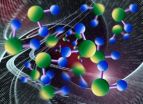(Press-News.org) Because modern computers have to depict the real world with digital representations of numbers instead of physical analogues, to simulate the continuous passage of time they have to digitize time into small slices. This kind of simulation is essential in disciplines from medical and biological research, to new materials, to fundamental considerations of quantum mechanics, and the fact that it inevitably introduces errors is an ongoing problem for scientists.
Scientists at the U.S. Department of Energy's Lawrence Berkeley National Laboratory (Berkeley Lab) have now identified and characterized the source of tenacious errors and come up with a way to separate the realistic aspects of a simulation from the artifacts of the computer method. The research was done by David Sivak and his advisor Gavin Crooks in Berkeley Lab's Physical Biosciences Division and John Chodera, a colleague at the California Institute of Quantitative Biosciences (QB3) at the University of California at Berkeley. The three report their results in Physical Review X.
"Our group uses a theoretical method called nonequilibrium statistical mechanics to study molecular machines, the protein complexes essential to processes like photosynthesis and DNA repair," says Sivak. "But when we applied common algorithms to model the behavior in biological molecules, we found persistent, significant errors in the simulation results."
Systems in equilibrium are relatively easy to simulate, but natural systems are often driven far from equilibrium by absorbing light, burning energy-dense chemical fuel, or other driving forces. Sivak, who recently joined the University of California at San Francisco as a Systems Biology Fellow, describes nonequilibrium statistical mechanics as "a way of understanding situations where conditions change abruptly and the system has to play catch-up," a kind of problem in which there are few exact analytical results.
How biological molecules move is hardly the only field where computer simulations of molecular-scale motion are essential. The need to use computers to test theories and model experiments that can't be done on a lab bench is ubiquitous, and the problems that Sivak and his colleagues encountered weren't new.
"A simulation of a physical process on a computer cannot use the exact, continuous equations of motion; the calculations must use approximations over discrete intervals of time," says Sivak. "It's well known that standard algorithms that use discrete time steps don't conserve energy exactly in these calculations."
One workhorse method for modeling molecular systems is Langevin dynamics, based on equations first developed by the French physicist Paul Langevin over a century ago to model Brownian motion. Brownian motion is the random movement of particles in a fluid (originally pollen grains on water) as they collide with the fluid's molecules – particle paths resembling a "drunkard's walk," which Albert Einstein had used just a few years earlier to establish the reality of atoms and molecules. Instead of impractical-to-calculate velocity, momentum, and acceleration for every molecule in the fluid, Langevin's method substituted an effective friction to damp the motion of the particle, plus a series of random jolts.
When Sivak and his colleagues used Langevin dynamics to model the behavior of molecular machines, they saw significant differences between what their exact theories predicted and what their simulations produced. They tried to come up with a physical picture of what it would take to produce these wrong answers.
"It was as if extra work were being done to push our molecules around," Sivak says. "In the real world, this would be a driven physical process, but it existed only in the simulation, so we called it 'shadow work.' It took exactly the form of a nonequilibrium driving force."
They first tested this insight with "toy" models having only a single degree of freedom, and found that when they ignored the shadow work, the calculations were systematically biased. But when they accounted for the shadow work, accurate calculations could be recovered.
"Next we looked at systems with hundreds or thousands of simple molecules," says Sivak. Using models of water molecules in a box, they simulated the state of the system over time, starting from a given thermal energy but with no "pushing" from outside. "We wanted to know how far the water simulation would be pushed by the shadow work alone."
The result confirmed that even in the absence of an explicit driving force, the finite-time-step Langevin dynamics simulation acted by itself as a driving nonequilibrium process. Systematic errors resulted from failing to separate this shadow work from the actual "protocol work" that they explicitly modeled in their simulations. For the first time, Sivak and his colleagues were able to quantify the magnitude of the deviations in various test systems.
Such simulation errors can be reduced in several ways, for example by dividing the evolution of the system into ever-finer time steps, because the shadow work is larger when the discrete time steps are larger. But doing so increases the computational expense.
The better approach is to use a correction factor that isolates the shadow work from the physically meaningful work, says Sivak. "We can apply results from our calculation in a meaningful way to characterize the error and correct for it, separating the physically realistic aspects of the simulation from the artifacts of the computer method."
INFORMATION:
"Using nonequilibrium fluctuation theorems to understand and correct errors in equilibrium and nonequilibrium discrete Langevin dynamics simulations," by David A. Sivak, John D. Chodera, and Gavin E. Crooks, will appear in Physical Review X and is now available as an arXiv preprint.
Lawrence Berkeley National Laboratory addresses the world's most urgent scientific challenges by advancing sustainable energy, protecting human health, creating new materials, and revealing the origin and fate of the universe. Founded in 1931, Berkeley Lab's scientific expertise has been recognized with 13 Nobel prizes. The University of California manages Berkeley Lab for the U.S. Department of Energy's Office of Science. For more, visit www.lbl.gov.
DOE's Office of Science is the single largest supporter of basic research in the physical sciences in the United States, and is working to address some of the most pressing challenges of our time. For more information, please visit the Office of Science website at science.energy.gov/.
How computers push on the molecules they simulate
Berkeley Lab bioscientists and their colleagues decipher a far-reaching problem in computer simulations
2013-01-03
ELSE PRESS RELEASES FROM THIS DATE:
Big brains are pricey, guppy study shows
2013-01-03
Bigger brains can make animals, well, brainier, but that boost in brain size and ability comes at a price. That's according to new evidence reported on January 3rd in Current Biology, a Cell Press publication, in which researchers artificially selected guppies for large and small brain sizes.
The findings lend support to the notion that bigger brains and increased cognitive ability do go together, a topic that has been a matter of considerable debate in recent years, said Niclas Kolm of Uppsala University in Sweden. They also represent some of the first convincing evidence ...
Japanese team creates cancer-specific killer T cells from induced pluripotent stem cells
2013-01-03
Researchers from the RIKEN Research Centre for Allergy and Immunology in Japan report today that they have succeeded for the first time in creating cancer-specific, immune system cells called killer T lymphocytes, from induced pluripotent stem cells (iPS cells). To create these killer cells, the team first had to reprogram T lymphocytes specialized in killing a certain type of cancer, into iPS cells. The iPS cells then generated fully active, cancer-specific T lymphocytes. These lymphocytes regenerated from iPS cells could potentially serve as cancer therapy in the future. ...
Revolutionary techniques could help harness patients' own immune cells to fight disease
2013-01-03
The human body contains immune cells programmed to fight cancer and viral infections, but they often have short lifespans and are not numerous enough to overcome attacks by particularly aggressive malignancies or invasions. Now researchers reporting in two separate papers in the January 4th issue of the Cell Press journal Cell Stem Cell used stem cell technology to successfully regenerate patients' immune cells, creating large numbers that were long-lived and could recognize their specified targets: HIV-infected cells in one case and cancer cells in the other. The findings ...
Stanford researchers use stem cells to pinpoint cause of common type of sudden cardiac death
2013-01-03
STANFORD, Calif. — When a young athlete dies unexpectedly on the basketball court or the football field, it's both shocking and tragic. Now Stanford University School of Medicine researchers have, for the first time, identified the molecular basis for a condition called hypertrophic cardiomyopathy that is the most common cause for this type of sudden cardiac death.
To do so, the Stanford scientists created induced pluripotent stem cells, or iPS cells, from the skin cells of 10 members of a family with a genetic mutation that causes the condition. The researchers then ...
In epigenomics, location is everything
2013-01-03
In a novel use of gene knockout technology, researchers at the University of California, San Diego School of Medicine tested the same gene inserted into 90 different locations in a yeast chromosome – and discovered that while the inserted gene never altered its surrounding chromatin landscape, differences in that immediate landscape measurably affected gene activity.
The findings, published online in the Jan. 3 issue of Cell Reports, demonstrate that regulation of chromatin – the combination of DNA and proteins that comprise a cell's nucleus – is not governed by a uniform ...
Researchers zero in on cognitive difficulties associated with menopause
2013-01-03
The memory problems that many women experience in their 40s and 50s as they approach and go through menopause are both real and appear to be most acute during the early period of post menopause. That is the conclusion of a study which appears today in the journal Menopause.
"Women going through menopausal transition have long complained of cognitive difficulties such as keeping track of information and struggling with mental tasks that would have otherwise been routine," said Miriam Weber, Ph.D. a neuropsychologist at the University of Rochester Medical Center (URMC) ...
New strategies needed to encourage male cancer survivors to consider future fertility
2013-01-03
Pioneering research presented at the Fertility 2013 conference today (Thursday 3 January 2013) shows that a large proportion of male cancer patients are missing out on appropriate fertility advice.
Sperm banking is routinely recommended for all men diagnosed with cancer who are at risk of long-term infertility, caused by treatment such as chemotherapy and radiotherapy.
Infertility can be permanent or temporary depending on the individual's circumstances and men may need to attend follow-up appointments to assess their fertility in the years after they have been discharged ...
Cup color influences the taste of hot chocolate
2013-01-03
Two researchers from the Polytechnic University of Valencia and the University of Oxford have proven that hot chocolate tastes better in an orange or cream coloured cup than in a white or red one. The study adds to recent research demonstrating how our senses perceive food in a different way depending on the characteristics of the container from which we eat and drink.
"The colour of the container where food and drink are served can enhance some attributes like taste and aroma," as explained to SINC by Betina Piqueras-Fiszman, researcher at the Polytechnic University ...
Scientists pinpoint molecular signals that make some women prone to miscarriage
2013-01-03
The research, carried out at Imperial College London and the University of Warwick, suggests these signals could be targets for drugs that would help prevent miscarriage in women who are particularly vulnerable.
At the start of pregnancy, the fertilised embryo must embed itself in the lining of the uterus. The uterus is only receptive to embryos for a few days in each menstrual cycle, ensuring that embryos can only implant at the right stage of development. Currently scientists know only a few details about the biological processes that control when an embryo can be implanted.
In ...
Hebrew University study finds key mechanism in calcium regulation
2013-01-03
Jerusalem, January 3, 2013 – All living cells keep their cellular calcium concentration at a very low level. Since a small increase in calcium can affect many critical cellular functions (an elevated calcium concentration over an extended period can induce cell death), powerful cellular mechanisms ensure that calcium concentration quickly returns to its low level.
It is known that impairments of cellular calcium regulation underlie almost all neurodegenerative diseases. For example, age-related loss of calcium regulation was shown to promote cell vulnerability in Alzheimer's ...
LAST 30 PRESS RELEASES:
Tracing the quick synthesis of an industrially important catalyst
New software sheds light on cancer’s hidden genetic networks
UT Health San Antonio awarded $3 million in CPRIT grants to bolster cancer research and prevention efforts in South Texas
Third symposium spotlights global challenge of new contaminants in China’s fight against pollution
From straw to soil harmony: International team reveals how biochar supercharges carbon-smart farming
Myeloma: How AI is redrawing the map of cancer care
Manhattan E. Charurat, Ph.D., MHS invested as the Homer and Martha Gudelsky Distinguished Professor in Medicine at the University of Maryland School of Medicine
Insilico Medicine’s Pharma.AI Q4 Winter Launch Recap: Revolutionizing drug discovery with cutting-edge AI innovations, accelerating the path to pharmaceutical superintelligence
Nanoplastics have diet-dependent impacts on digestive system health
Brain neuron death occurs throughout life and increases with age, a natural human protein drug may halt neuron death in Alzheimer’s disease
SPIE and CLP announce the recipients of the 2025 Advanced Photonics Young Innovator Award
Lessons from the Caldor Fire’s Christmas Valley ‘Miracle’
Ant societies rose by trading individual protection for collective power
Research reveals how ancient viral DNA shapes early embryonic development
A molecular gatekeeper that controls protein synthesis
New ‘cloaking device’ concept to shield sensitive tech from magnetic fields
Researchers show impact of mountain building and climate change on alpine biodiversity
Study models the transition from Neanderthals to modern humans in Europe
University of Phoenix College of Doctoral Studies releases white paper on AI-driven skilling to reduce burnout and restore worker autonomy
AIs fail at the game of visual “telephone”
The levers for a sustainable food system
Potential changes in US homelessness by ending federal support for housing first programs
Vulnerability of large language models to prompt injection when providing medical advice
Researchers develop new system for high-energy-density, long-life, multi-electron transfer bromine-based flow batteries
Ending federal support for housing first programs could increase U.S. homelessness by 5% in one year, new JAMA study finds
New research uncovers molecular ‘safety switch’ shielding cancers from immune attack
Bacteria resisting viral infection can still sink carbon to ocean floor
Younger biological age may increase depression risk in older women during COVID-19
Bharat Innovates 2026 National Basecamp Showcases India’s Most Promising Deep-Tech Ventures
Here’s what determines whether your income level rises or falls
[Press-News.org] How computers push on the molecules they simulateBerkeley Lab bioscientists and their colleagues decipher a far-reaching problem in computer simulations




